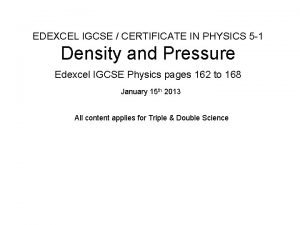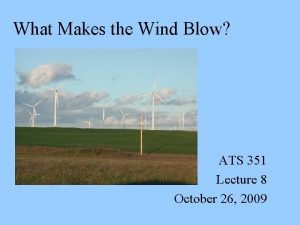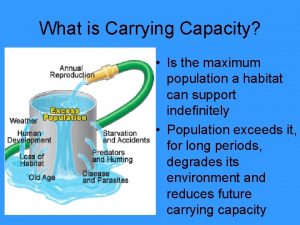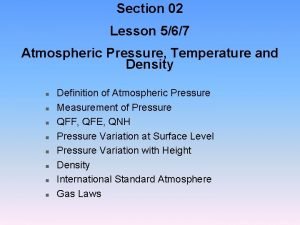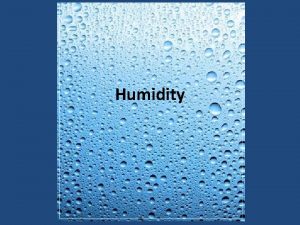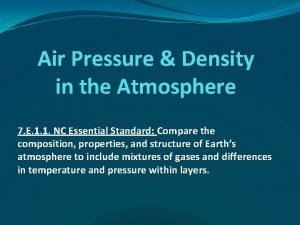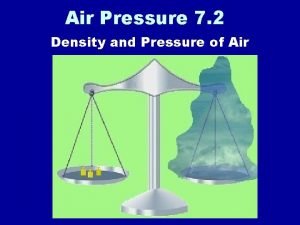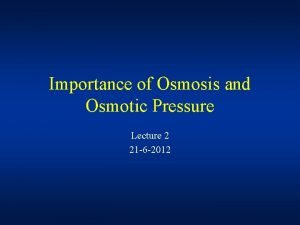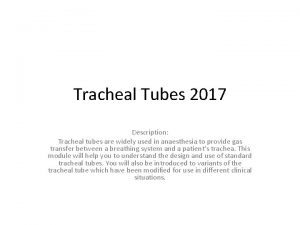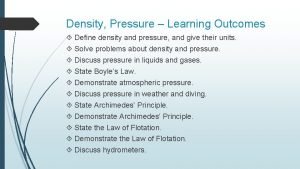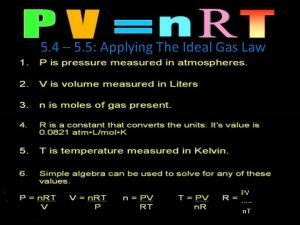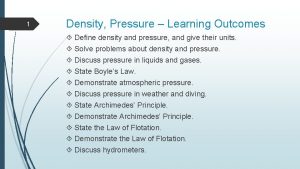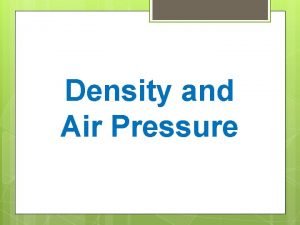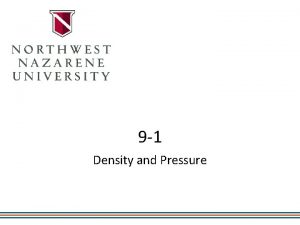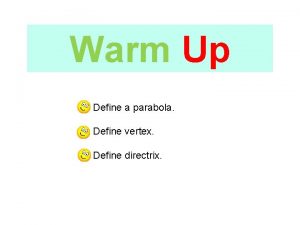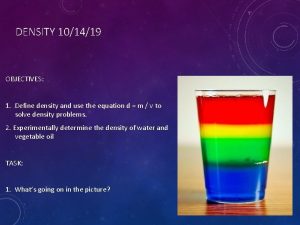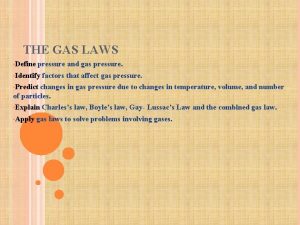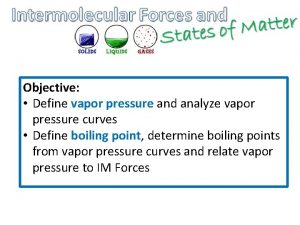Density and Pressure Density and Pressure Define density




















- Slides: 20

Density and Pressure

Density and Pressure Define density Understand relative density Define and use the term pressure Learn the instruments used for measuring pressure • Brownian Motion and the Kinetic Model • Pressure in a Gas • Melting, Boiling and Evaporation • •

Density • • Mass per unit volume Units: kgm-3, gcm-3, gml-1 Density is changes with temperature Relative Density – Density of a substance divided density of water – Dimensionless – Density of water is 1000 kgm-3

Densities of Some Substances

Comparing Densities • When most substances change from a solid state to a liquid state their volume does not change much. – Density of a solid is almost the same as a liquid.

Comparing Densities • When a liquid changes into a gas, the spacing between the particles increases by a factor of about ten. • As a result, the density of a substance decreases by a factor of approximately 1000 when it changes from a liquid to a gas.

Sample Calculations • A cup of gold colored metal beads was measured to have a mass 425 grams. By water displacement, the volume of the beads was calculated to be 48. 0 cm 3. Identify the metal. • A 60 -ml flask is filled with mercury at 0 C. When the temperature rises to 80 C, 1. 47 g of mercury spills out of the flask. Assuming that the volume of the flask is constant, find the density of mercury at 80 C if its density at 0 C is 13, 645 kgm-3.

Pressure • • • Force per unit area Force is normal to the area Units: Nm-2, kgm-1 s-2, Pascal (Pa) Fluid Pressure Equation

Fluid Pressure • Equation • Absolute pressure • Gauge pressure

Measuring Pressure • Mercury Barometer • U-tube Manometer • Equation

Sample Calculations • A U-tube contains liquid of unknown density. An oil of density 800 kgm-3 is poured into one arm of the tube until the oil column is 12 cm high. The oil-air interface is 5. 0 cm above the liquid level in the other arm of the tube. Find the density of the liquid. • P 400, #22. 18 (a)

Brownian Motion

Brownian Motion

Brownian Motion Video 1

Brownian Motion Video 2

Kinetic Theory of Matter All matter is made up of a large number of tiny atoms or molecules which are in continuous motion

Pressure of a Gas • Force that the gas molecules exert as they hit the walls of the container

Energies and Molecules • Potential Energy • Distance between molecules • Kinetic Energy • Related to temperature of the substance • Internal Energy • The sum of the kinetic and potential energies of a substance.

Melting and Boiling • Heat is added to break bonds between molecules • Some part of the energy is used to work against the environment • Both occur at a specific constant temperature • Let us look at the energies involved

Boiling and Evaporation • Both involve changes from liquid to gas • Boiling occurs at a specific temperature • Evaporation occurs at any temperature • Boiling occurs inside the liquid • Evaporation occurs at the surface of the liquid
 Igcse density questions
Igcse density questions Specific gravity units
Specific gravity units Planar density fcc 100
Planar density fcc 100 Linear density and planar density
Linear density and planar density Warm air aloft is normally associated with
Warm air aloft is normally associated with Relationship between air pressure and density
Relationship between air pressure and density Airnnn
Airnnn Relationship between air pressure and density
Relationship between air pressure and density Relationship between air pressure and density
Relationship between air pressure and density Relationship between air pressure and density
Relationship between air pressure and density Static pressure and dynamic pressure
Static pressure and dynamic pressure Hydrostatic vs osmotic pressure
Hydrostatic vs osmotic pressure High pressure and low pressure
High pressure and low pressure What is low pressure
What is low pressure Crude population density vs physiological density
Crude population density vs physiological density High density low density
High density low density Why is arithmetic density also called crude density?
Why is arithmetic density also called crude density? Pressure density
Pressure density Pressure density
Pressure density Vizglow
Vizglow Calculate the density of xenon gas at a pressure of 742
Calculate the density of xenon gas at a pressure of 742
